Samuel Langhorne Clemens, better known as Mark Twain, transformed American literature with his wit, social commentary, and masterful storytelling. Born in a small Missouri town, his journey from riverboat pilot to world-renowned author captures the essence of 19th-century America. This exploration of the life of Mark Twain reveals how his experiences shaped classics like “The Adventures of Tom Sawyer” and “Adventures of Huckleberry Finn” while establishing him as one of history’s most beloved writers.
Mark Twain in his signature white suit, which became his trademark in later years
Early Years: The Making of Mark Twain
Samuel Langhorne Clemens was born on November 30, 1835, in the small village of Florida, Missouri. He was the sixth of seven children born to John Marshall Clemens and Jane Lampton Clemens. When Sam was just four years old, the family moved to Hannibal, Missouri, a bustling port town on the Mississippi River that would later provide the setting for his most famous works.
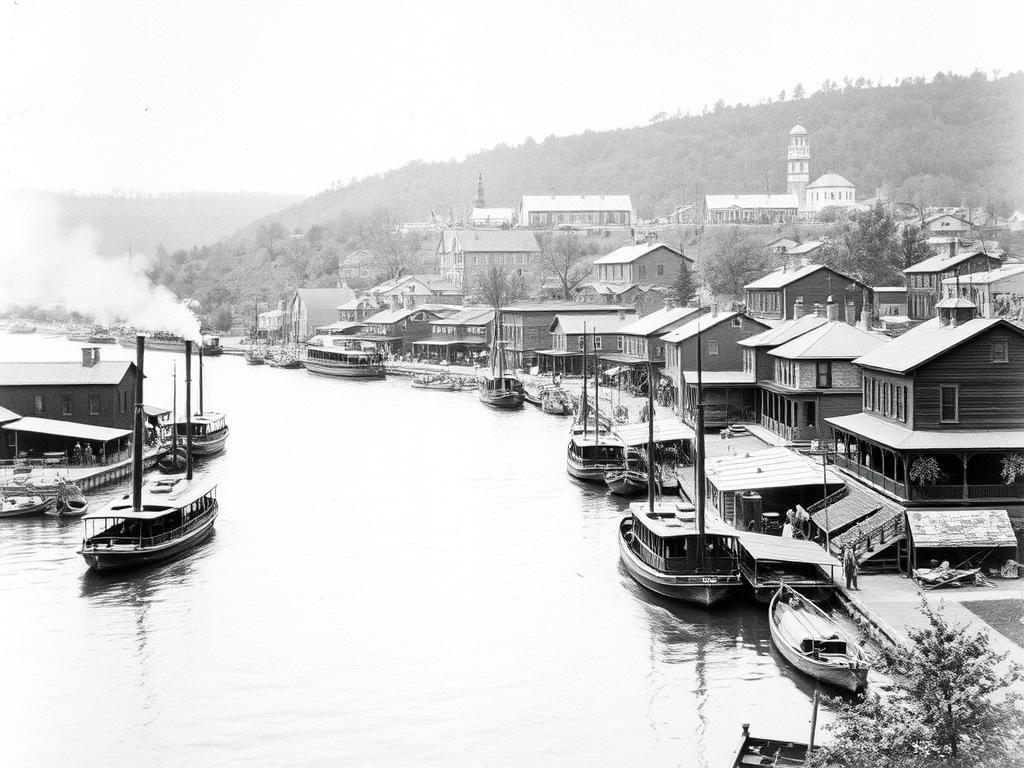
Hannibal, Missouri along the Mississippi River in the 1840s, where young Samuel Clemens spent his formative years
Life in Hannibal provided young Sam with experiences that would fuel his imagination for decades to come. The town, with its riverboat traffic, colorful characters, and proximity to the mighty Mississippi, became the foundation for the fictional St. Petersburg in “The Adventures of Tom Sawyer” and “Adventures of Huckleberry Finn.”
Family Struggles and Early Responsibilities
The Clemens family faced significant financial hardships throughout Sam’s childhood. His father, though trained as a lawyer, struggled in business ventures and land speculation. When John Clemens died of pneumonia in 1847, twelve-year-old Sam was forced to end his formal education and begin working to help support his family.
“It put our energies to sleep and made visionaries of us—dreamers and indolent.…It is good to begin life poor; it is good to begin life rich—these are wholesome; but to begin it prospectively rich! The man who has not experienced it cannot imagine the curse of it.”
Sam’s first job was as a printer’s apprentice for Joseph P. Ament’s Missouri Courier. This early exposure to the printing trade would prove invaluable, teaching him not only technical skills but also exposing him to various writing styles and storytelling techniques. By 1851, he was working for his older brother Orion’s newspaper, the Western Union, where he published his first known sketches.

Young Samuel Clemens learning the printing trade as an apprentice
Life on the Mississippi: The Riverboat Years
In 1857, at the age of twenty-two, Samuel Clemens embarked on what would become one of the most formative chapters in his life. Abandoning his printing career, he became an apprentice to steamboat pilot Horace Bixby, who agreed to teach him the Mississippi River for a fee of $500—a substantial sum at that time.
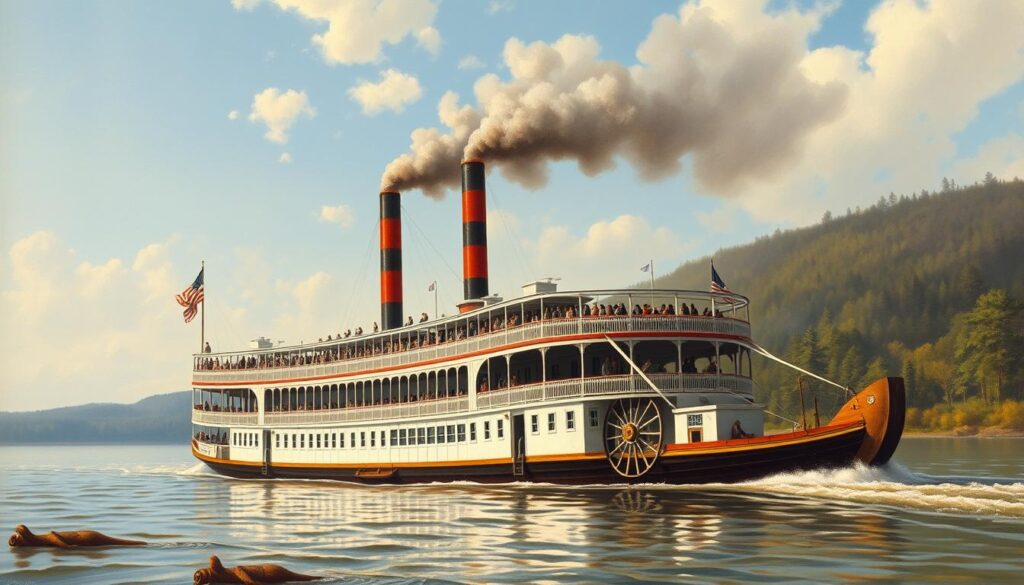
A Mississippi River steamboat similar to those piloted by Samuel Clemens in the late 1850s
Learning to navigate the Mississippi was no small feat. The river constantly changed its course, revealed and concealed sandbars, and presented numerous hazards to steamboats. Clemens had to memorize hundreds of miles of the river in both directions and under all conditions—day, night, and in various seasons.
“I can ‘bank’ in the neighborhood of $100 a month… and that will satisfy me for the present…. Bless me!… what respect Prosperity commands. Why, six months ago, I could enter the ‘Rooms,’ [of the Western Boatmen’s Benevolent Association] and receive only the customary fraternal greeting—but now they say, ‘Why how are you, old fellow—when did you get in?'”
After earning his pilot’s license in 1859, Clemens enjoyed a brief but successful career as a riverboat pilot. This period provided him with a steady income, independence, and exposure to a wide variety of people and experiences. More importantly, it was during this time that he adopted his famous pen name, “Mark Twain”—a riverboat term meaning two fathoms (twelve feet) deep, which indicated safe water for passage.
The Civil War and the End of River Days
Clemens’s promising career as a riverboat pilot came to an abrupt end with the outbreak of the Civil War in 1861. Commercial traffic on the Mississippi was halted, forcing him to seek new opportunities. After a brief and uneventful two-week stint with a Confederate militia unit called the Marion Rangers, Clemens headed west with his brother Orion, who had been appointed as secretary to the territorial governor of Nevada.
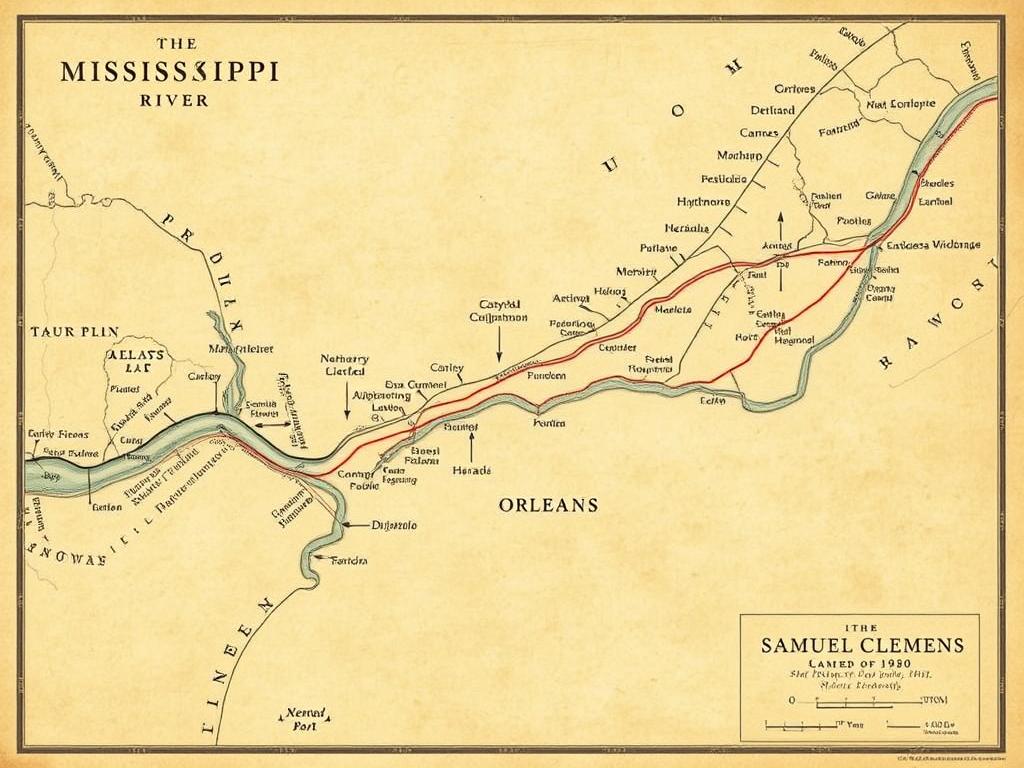
Map of the Mississippi River routes that Samuel Clemens navigated during his years as a riverboat pilot
Western Adventures and the Birth of Mark Twain
The journey west marked a significant turning point in Clemens’s life. Initially working as his brother’s secretary in Nevada Territory, he soon caught “silver fever” and tried his hand at mining and prospecting. Though he failed to strike it rich in the silver mines, this period provided rich material for his later writings, particularly “Roughing It” (1872).
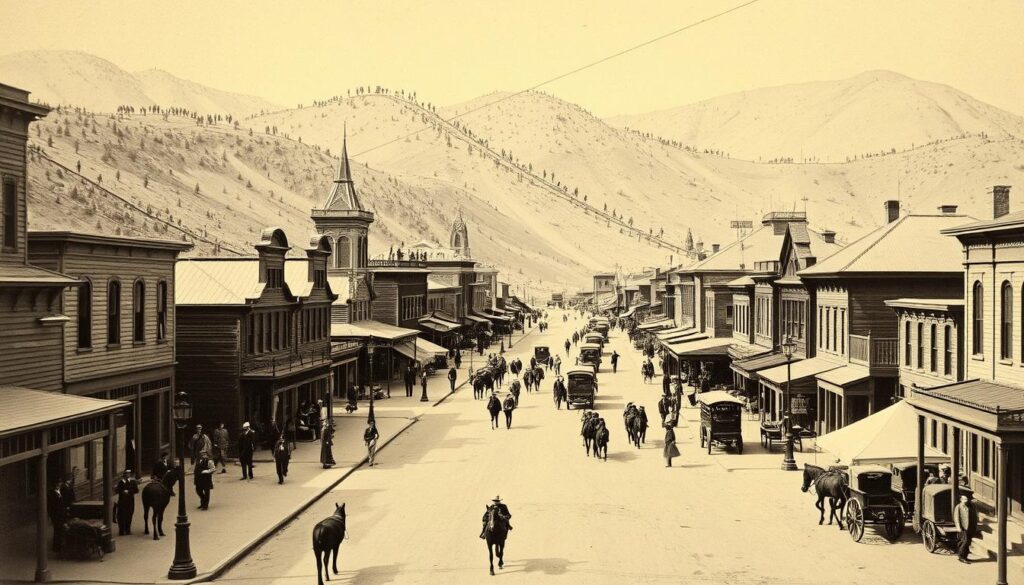
Virginia City, Nevada in the 1860s, where Clemens worked for the Territorial Enterprise newspaper
When his mining ventures failed, Clemens returned to journalism, joining the staff of the Virginia City Territorial Enterprise in 1862. It was here that he first began signing his work as “Mark Twain.” His humorous sketches and articles for the newspaper quickly gained popularity, establishing his reputation as a talented writer with a distinctive voice.
The Jumping Frog and First Literary Success
In 1865, Clemens’s humorous short story “Jim Smiley and His Jumping Frog” (later republished as “The Celebrated Jumping Frog of Calaveras County”) was published in the New York Saturday Press. The story’s success brought him national attention and marked his emergence as a significant literary figure.
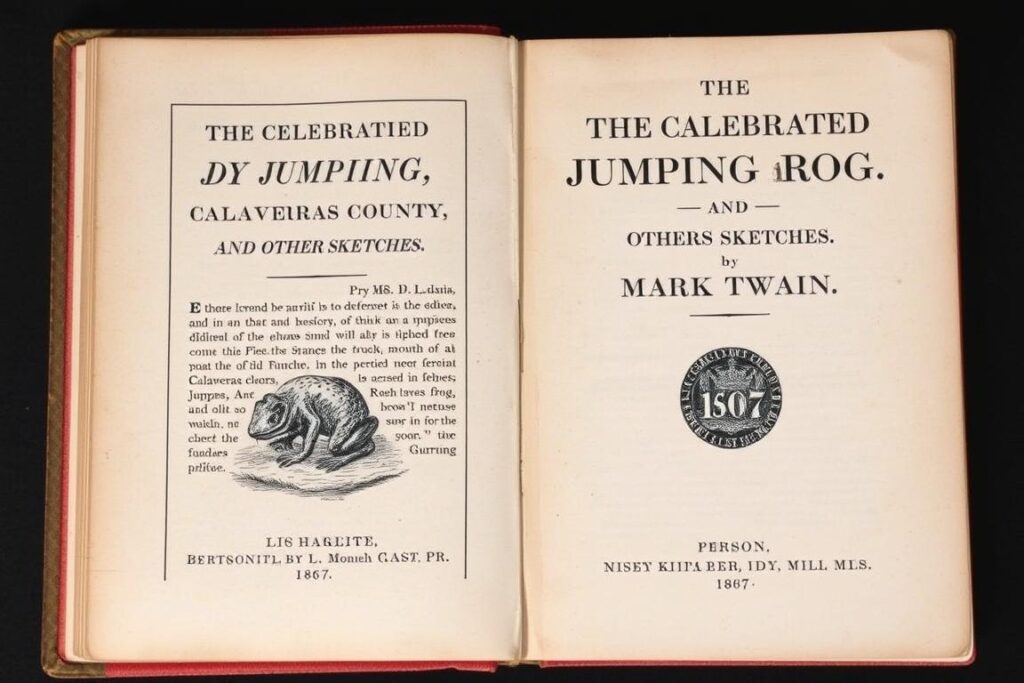
First edition cover of “The Celebrated Jumping Frog of Calaveras County and Other Sketches” (1867)
Building on this success, Clemens embarked on a lecture tour and secured a position as a traveling correspondent for the San Francisco Alto California. In 1867, he joined a group of Americans on a tour of Europe and the Holy Land aboard the steamship Quaker City. His humorous travel letters about this journey formed the basis for his first book, “The Innocents Abroad” (1869), which established him as a popular author.
Literary Career and Major Works
After returning from his travels, Clemens met Olivia Langdon, whom he married in 1870. The couple settled in Hartford, Connecticut, where they raised their family and where Clemens produced most of his best-known works. The 1870s and 1880s marked the peak of his literary career, during which he published his most enduring classics.

Mark Twain’s home in Hartford, Connecticut, where he wrote his most famous works (1874-1891)
The Adventures of Tom Sawyer
Published in 1876, “The Adventures of Tom Sawyer” drew heavily on Clemens’s childhood experiences in Hannibal. The novel follows the adventures of a mischievous boy growing up along the Mississippi River. With its vivid portrayal of childhood and small-town American life, the book became an immediate success and remains a beloved classic.

Original illustration from the first edition of “The Adventures of Tom Sawyer” (1876)
Adventures of Huckleberry Finn
Often considered Twain’s masterpiece, “Adventures of Huckleberry Finn” was published in 1884. The novel follows Huck Finn, Tom Sawyer’s companion, as he flees his abusive father and travels down the Mississippi with Jim, an escaped slave. Through their journey, Twain explores themes of racism, freedom, and moral growth, creating what many consider the first truly American novel.
“You don’t know about me without you have read a book by the name of The Adventures of Tom Sawyer; but that ain’t no matter. That book was made by Mr. Mark Twain, and he told the truth, mainly. There was things which he stretched, but mainly he told the truth.”
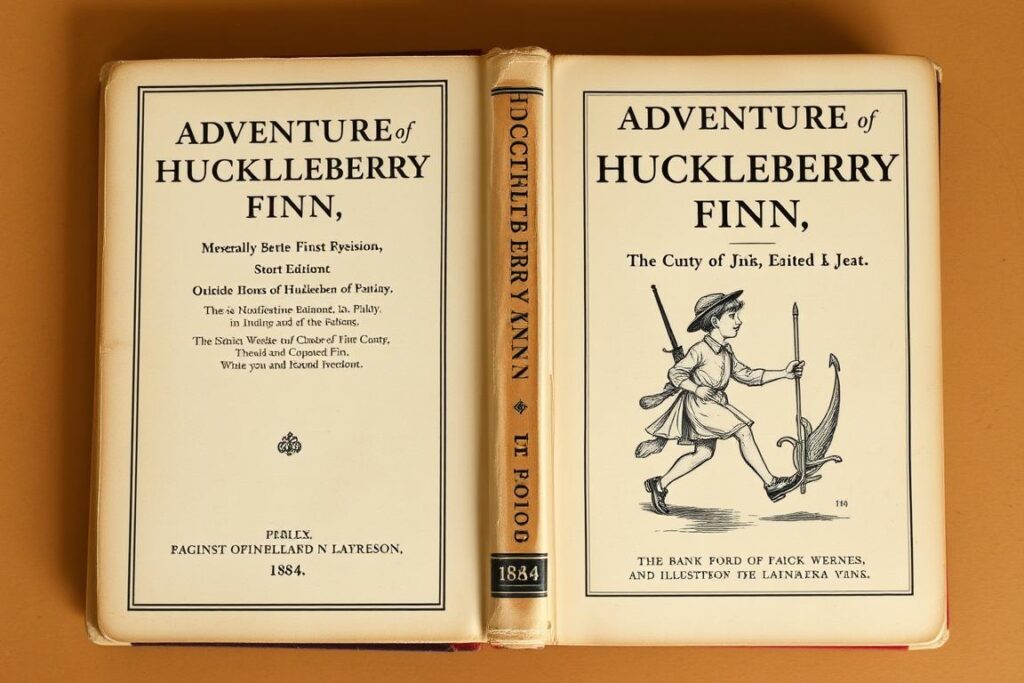
First edition cover of “Adventures of Huckleberry Finn” (1884)
Other Notable Works
Explore Mark Twain’s Complete Works
Discover the full range of Mark Twain’s literary genius with our comprehensive reading guide. From his early sketches to his later essays, understand the development of his unique voice and perspective.
Personal Life and Family
Behind the public persona of Mark Twain was Samuel Clemens, a devoted family man whose personal life was marked by both joy and tragedy. His marriage to Olivia Langdon in 1870 began a partnership that would last until her death in 1904.
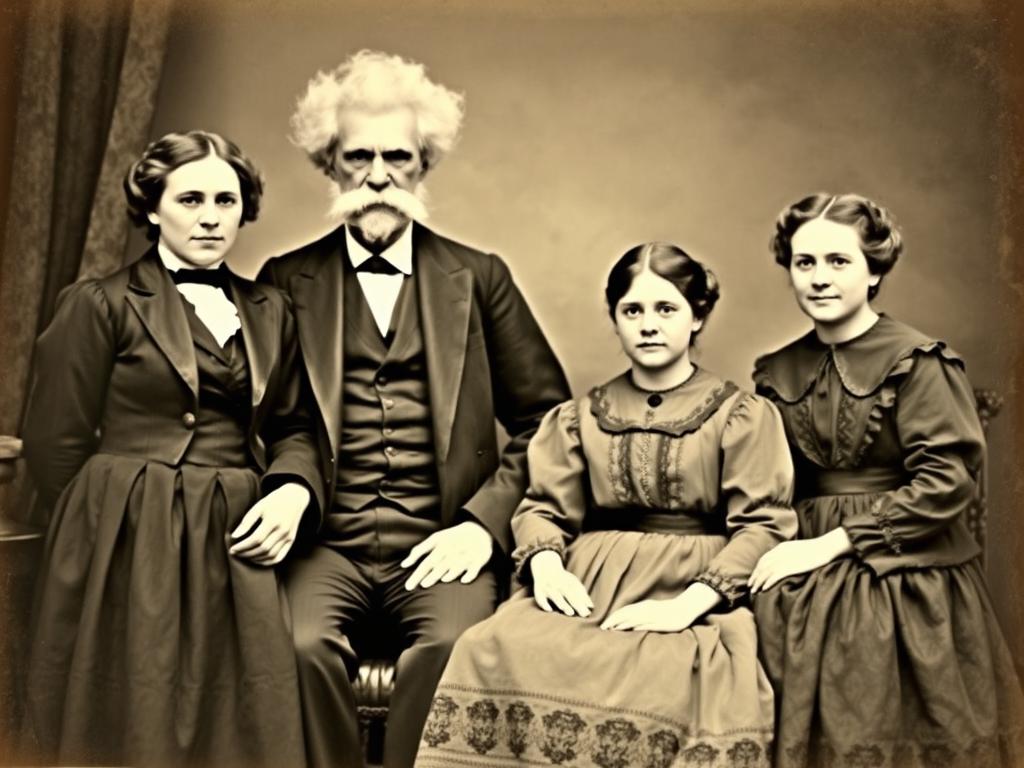
Mark Twain with his wife Olivia and their daughters Susy, Clara, and Jean
The Clemens family had four children: a son, Langdon, who died in infancy; and three daughters, Susy, Clara, and Jean. Family life centered around their Hartford home and later at Quarry Farm in Elmira, New York, where Clemens did much of his writing in a special study built for him.
Financial Troubles and Personal Tragedies
Despite his literary success, Clemens faced significant financial difficulties throughout his life. His investments in various ventures, particularly the Paige typesetter (an automatic typesetting machine), led to bankruptcy in 1894. To pay off his debts, he embarked on a worldwide lecture tour in 1895.

The Paige Compositor typesetting machine, in which Twain invested heavily, leading to his financial ruin
While Clemens was abroad on this tour, his daughter Susy died of meningitis at age 24. This devastating loss was followed by the death of his wife Olivia in 1904 and his daughter Jean in 1909. These personal tragedies deeply affected his outlook and writings in his later years.
“The fear of death follows from the fear of life. A man who lives fully is prepared to die at any time.”
Later Years and Legacy
In his final years, Clemens became increasingly pessimistic and critical of human nature, though he maintained his sharp wit. His later writings often reflected darker themes and social criticism. Despite personal tragedies and financial setbacks, he remained a beloved public figure, instantly recognizable with his white suit, wild hair, and mustache.
Mark Twain in his later years, sporting his trademark white suit and mustache
Final Days and Death
Clemens spent his final years at his home called Stormfield in Redding, Connecticut. On April 21, 1910, at the age of 74, Samuel Langhorne Clemens died of a heart attack. His death came one day after the closest approach of Halley’s Comet, an event he had predicted, having been born during its previous appearance in 1835.
“I came in with Halley’s Comet in 1835. It is coming again next year, and I expect to go out with it. It will be the greatest disappointment of my life if I don’t go out with Halley’s Comet. The Almighty has said, no doubt: ‘Now here are these two unaccountable freaks; they came in together, they must go out together.'”

Stormfield, Mark Twain’s final home in Redding, Connecticut (1908-1910)
Enduring Influence
Mark Twain’s influence on American literature and culture cannot be overstated. Ernest Hemingway famously declared that “all modern American literature comes from one book by Mark Twain called Huckleberry Finn.” His innovative use of vernacular speech, realistic portrayal of American life, and incisive social commentary revolutionized American writing.

Mark Twain’s grave in Woodlawn Cemetery, Elmira, New York
Today, Twain’s works continue to be read, studied, and adapted worldwide. His childhood home in Hannibal, Missouri, his adult home in Hartford, Connecticut, and various other sites associated with his life have become museums and tourist attractions, testifying to his enduring popularity and significance.
Mark Twain in His Own Words
Mark Twain was renowned for his wit and wisdom, expressed through countless memorable quotes. Here are some of his most famous observations that continue to resonate today:
On Life and Human Nature
“The secret of getting ahead is getting started.”
“Kindness is the language which the deaf can hear and the blind can see.”
“The best way to cheer yourself up is to try to cheer somebody else up.”
On Writing and Truth
“If you tell the truth, you don’t have to remember anything.”
“The difference between the almost right word and the right word is the difference between the lightning bug and the lightning.”
“A successful book is not made of what is in it, but of what is left out of it.”
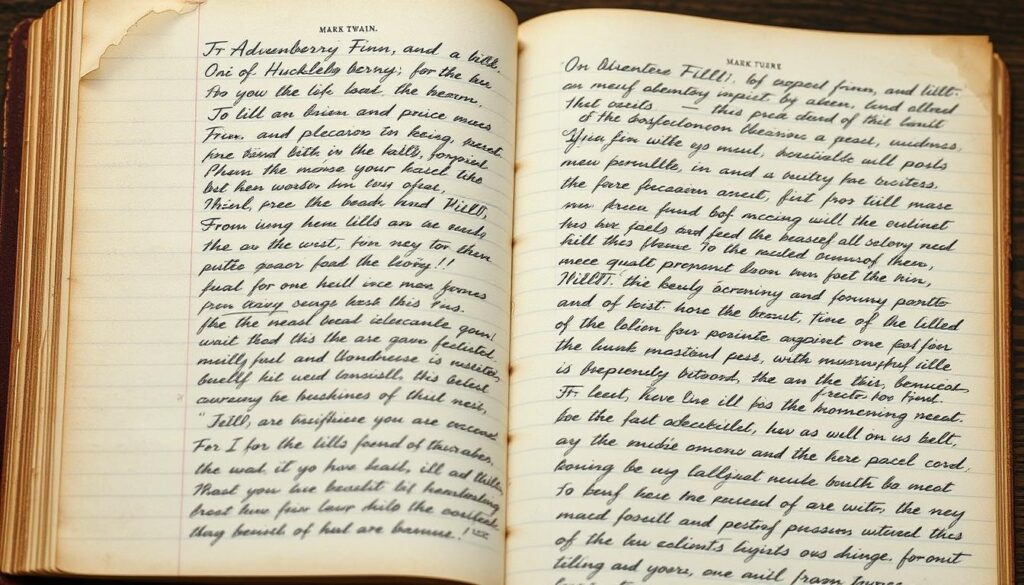
A page from Mark Twain’s handwritten manuscript of “Adventures of Huckleberry Finn”
Places That Shaped Mark Twain
Throughout his life, Mark Twain was influenced by the various places he called home. These locations not only shaped his personal experiences but also provided settings and inspiration for his literary works.
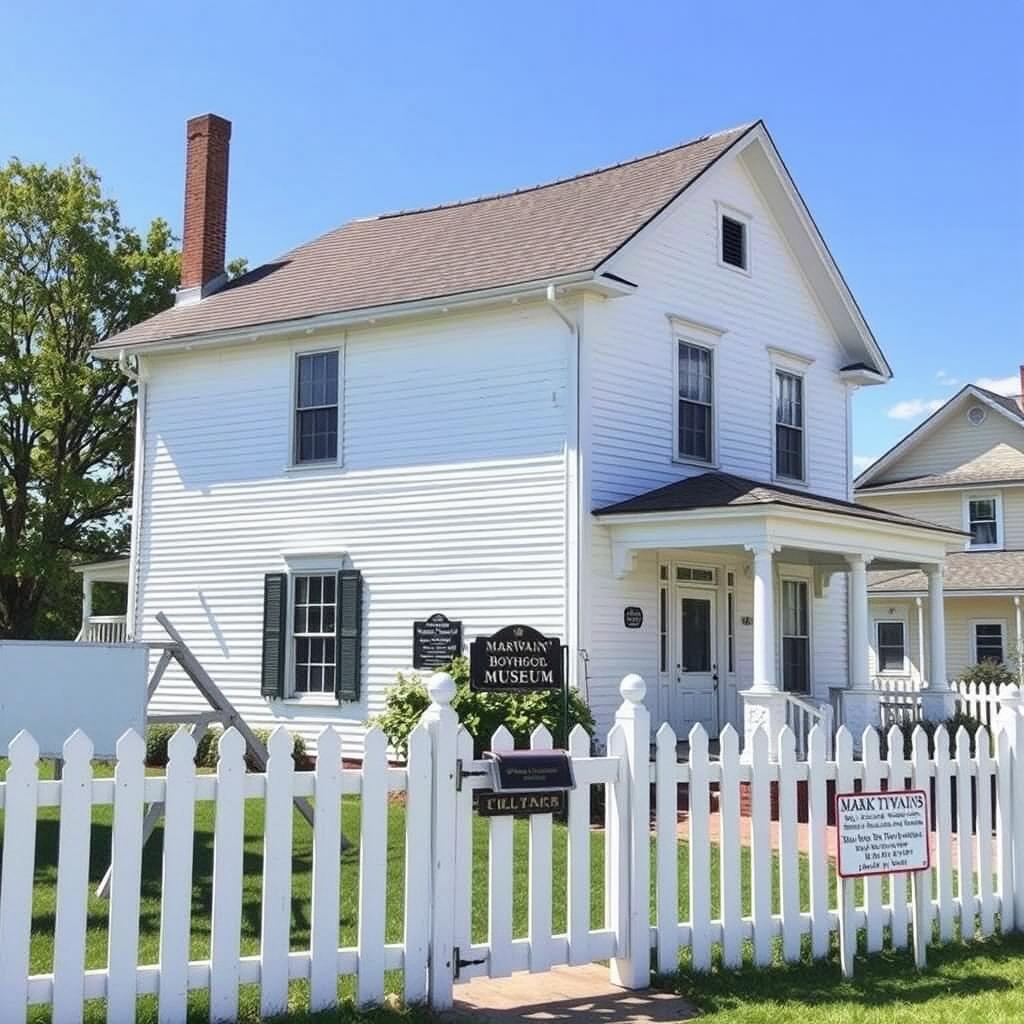
Hannibal, Missouri
The Mississippi River town where Clemens spent his childhood became the model for St. Petersburg in “Tom Sawyer” and “Huckleberry Finn.” Today, the Mark Twain Boyhood Home is a museum that preserves his early environment.

Hartford, Connecticut
The Clemens family lived in this Victorian Gothic house from 1874 to 1891. It was here that Twain wrote his most famous works, including “The Adventures of Tom Sawyer,” “Adventures of Huckleberry Finn,” and “A Connecticut Yankee in King Arthur’s Court.”

Elmira, New York
Quarry Farm, the summer home of Olivia’s sister, became a retreat for the Clemens family. Twain wrote in a special octagonal study built for him on the property, with views of the Chemung River Valley that reminded him of the Mississippi.
Mark Twain’s Enduring Relevance
More than a century after his death, Mark Twain’s work continues to resonate with readers worldwide. His insights into human nature, his criticism of social injustice, and his celebration of American vernacular speech ensure his place not just as a historical figure but as a writer whose voice speaks to contemporary concerns.

Students continue to study and discuss Mark Twain’s works in classrooms around the world
Literary Influence
Twain’s innovative approach to American literature opened doors for generations of writers who followed. His use of local dialects, realistic characters, and unflinching social commentary established a distinctly American literary voice. Authors from William Faulkner to Ernest Hemingway, Toni Morrison to George Saunders have acknowledged their debt to Twain’s groundbreaking work.
Social Commentary
Twain’s critiques of racism, imperialism, and social hypocrisy remain relevant in today’s discussions of social justice. “Adventures of Huckleberry Finn,” with its complex exploration of race relations in pre-Civil War America, continues to provoke important conversations about America’s troubled history and ongoing struggles with equality.
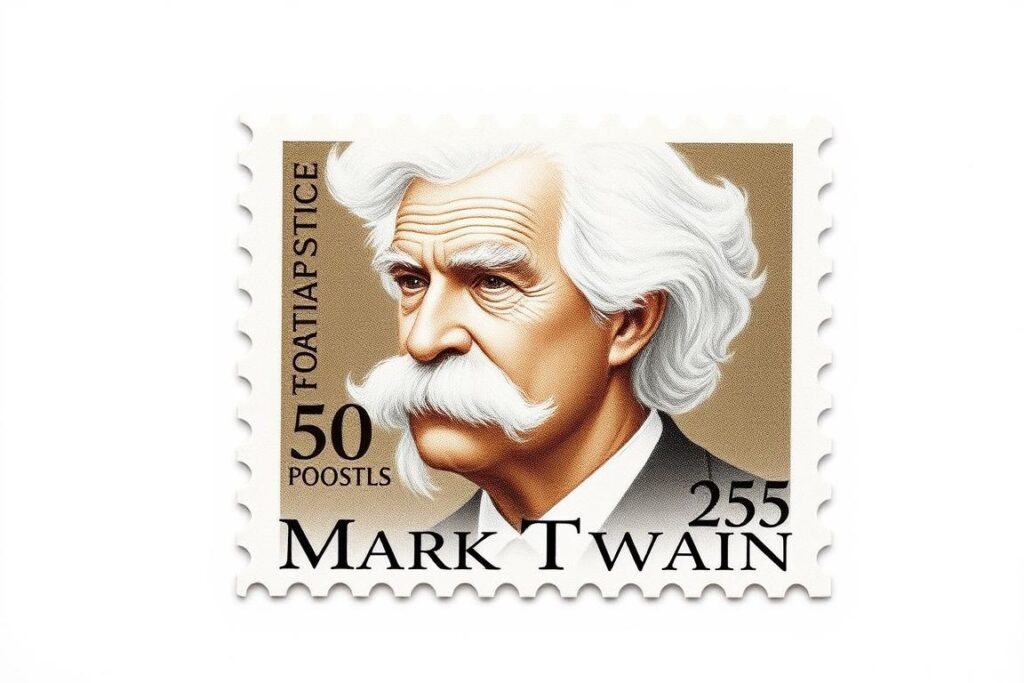
Mark Twain commemorative stamp issued by the US Postal Service, recognizing his cultural significance
Popular Culture
Twain’s influence extends beyond literature into popular culture. His works have been adapted countless times for film, television, theater, and other media. His distinctive image—white suit, wild hair, and mustache—remains instantly recognizable, and his witticisms are quoted in contexts ranging from political speeches to internet memes.
Conclusion: The Legacy of Mark Twain
The life of Mark Twain represents a quintessentially American journey—from humble beginnings on the frontier to international fame as a writer and lecturer. His experiences as a riverboat pilot, prospector, journalist, and author gave him unique insights into American society during a period of tremendous change and growth.
Twain’s literary achievements transformed American literature, establishing a voice and style that was distinctly American rather than derivative of European traditions. His masterpieces, particularly “Adventures of Huckleberry Finn,” continue to be regarded as foundational texts in the American literary canon.

The Mississippi River at sunset, a landscape that shaped Mark Twain’s life and work
Beyond his literary contributions, Twain’s wit, wisdom, and social commentary continue to provide insights into human nature and society. His ability to combine humor with profound observations about life ensures that his work remains not only historically significant but also personally meaningful to readers today.
As we reflect on the life of Mark Twain, we recognize a man who embodied the contradictions and possibilities of America itself—optimistic yet critical, humorous yet profound, accessible yet complex. His enduring legacy reminds us of literature’s power to entertain, challenge, and transform.
Stay Connected with American Literary History
Join our newsletter to receive monthly insights about Mark Twain and other classic American authors. Get reading recommendations, historical context, and news about literary events and discoveries.













